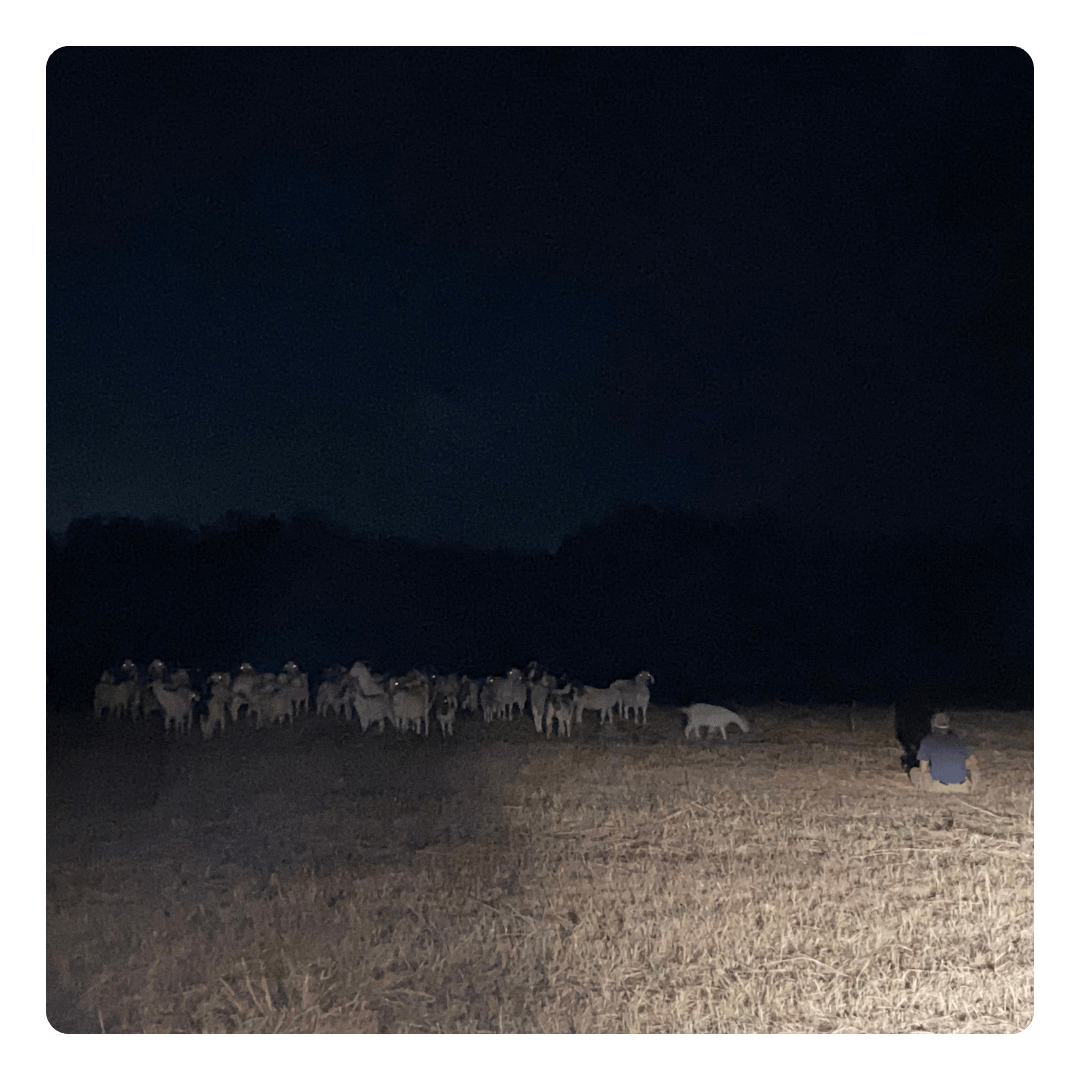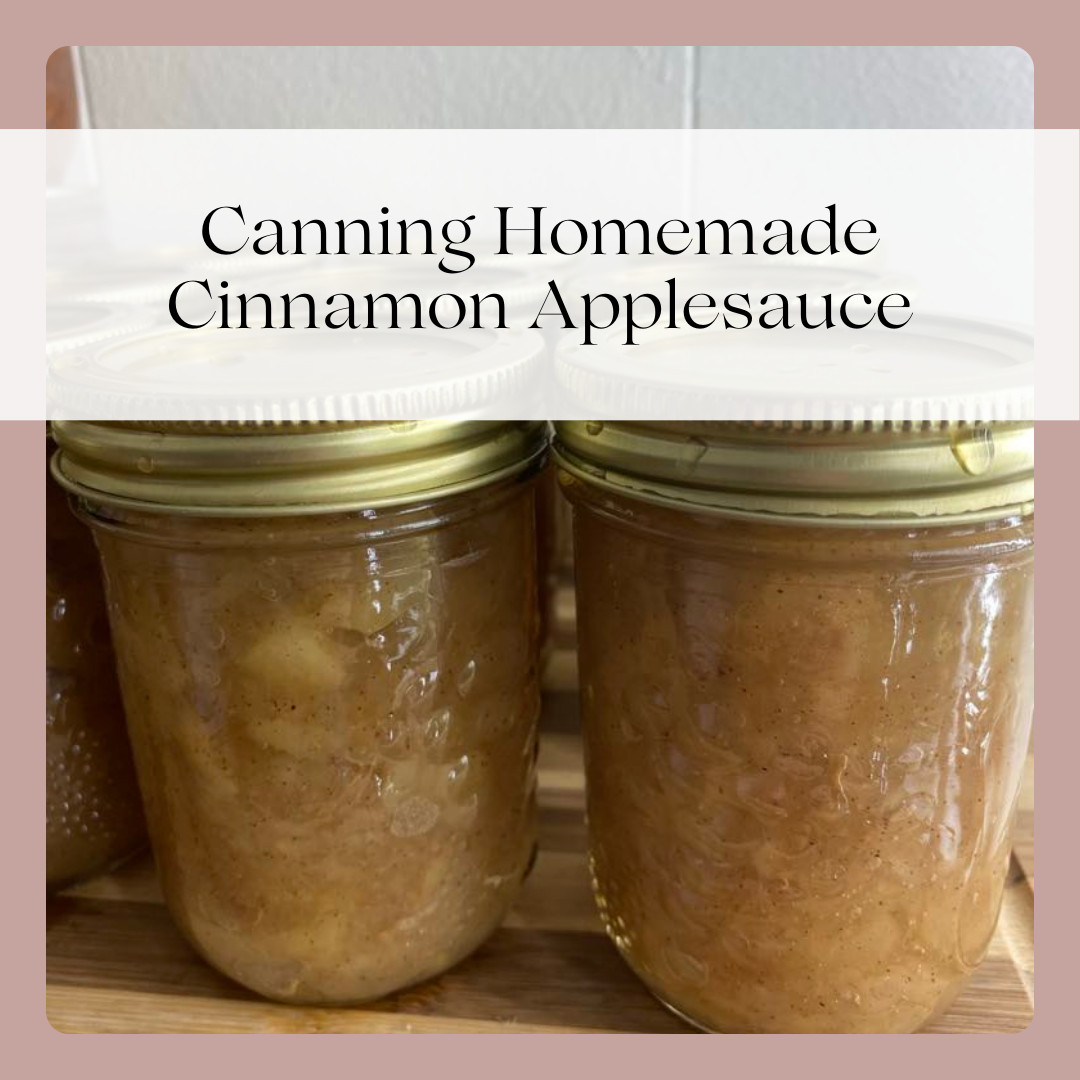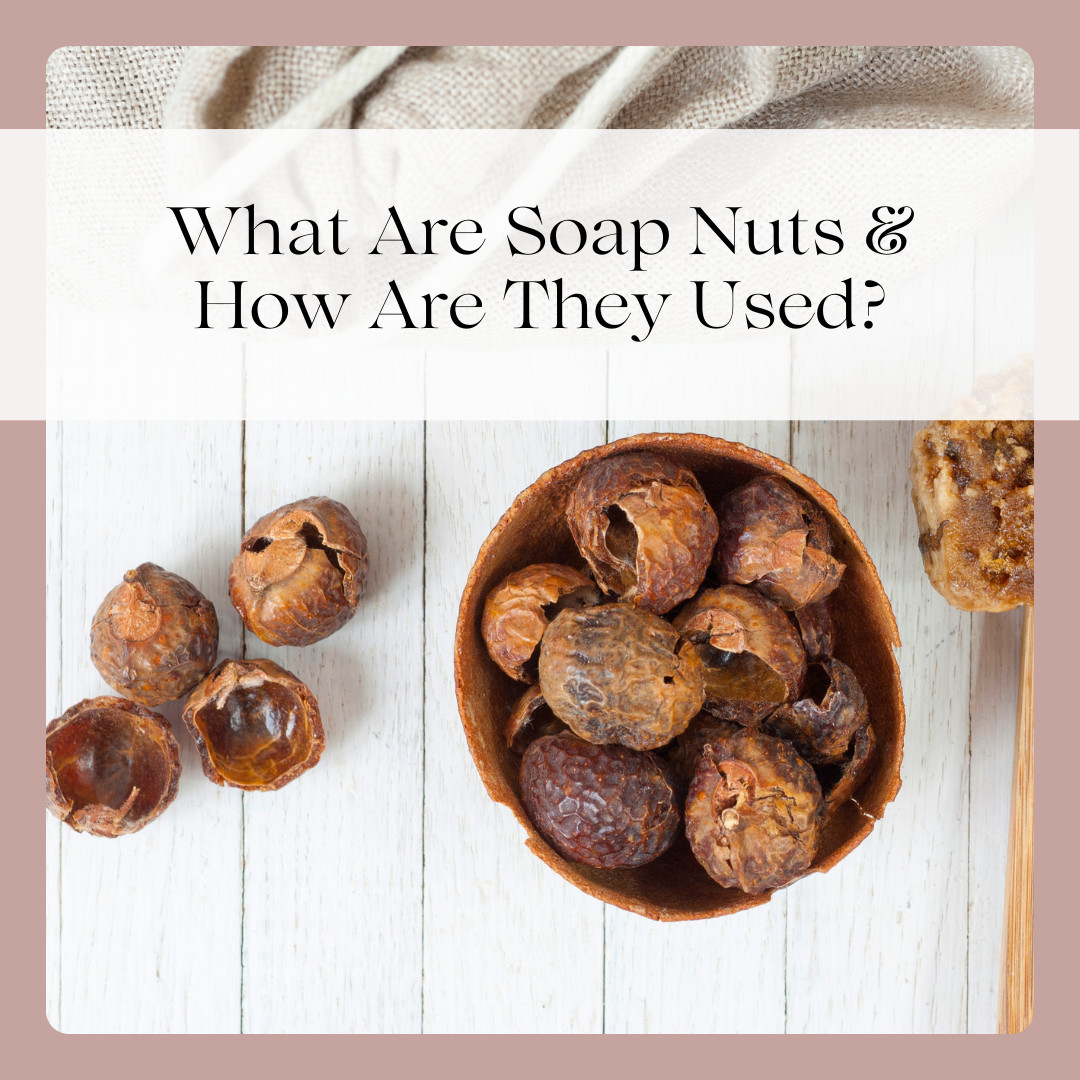
Last night was a big night for us. We moved our 51 goats onto their new land. We have kind of done this whole "homesteading" thing a bit backwards. We got the goats and guardian dogs before we had any land. And then we had to move our dogs to another piece of land, leaving the goats where they were for almost a year. So we have been working on moving the goats for a few months now. And, no, neither piece of land has been our own. We have been blessed to have friends who offer up their land for us to use while we work towards owning our own property.
Now our pups and the goats are all on the same land, but not together just yet. It will take a little bit of time to get them all situated to where they can all be together as planned. Like I said, we have been doing this whole thing backwards.
We had a bit of a late start last night, due to our hard working guys and their work schedules. So we weren't even able to get things started until 5-6 pm. All 3 of my guys went to the new land to check the new fencing and finish preparing it. Then my hubby stayed behind to finish up while our boys went with our friends to pick up the goats in their horse trailer. By this time, sunset was quickly coming. Thankfully they were able to load ALL 51 goats into the trailer. Then they made the 15 mile drive and safely delivered them to their new home.

As if that isn't exciting enough, we realized that some bales of hay needed to be moved OUT of the fenced in area. So, after dark, after the goats were unloaded, it was time to move the hay. In the process, the goats got out...maybe all of them, I'm not really sure...I just know there were a lot of goats to get back into the fence. One of them, called Skittish (rightfully so), wouldn't come back. She hid off somewhere in the tall grasses.
We decided to stay close by the area the goats were in to make sure they didn't escape again while the hay was being moved. When it was time to go, I drove slowly back down the drive. Thankfully we found our missing goat! She was just outside the fence, between the fence and the hay bales, looking for a way back in. My two sons corralled her using the bales of hay and she found her way back into the fence and headed towards the rest of the herd.
When the hay was all moved, the fence was tested and seemed to be working fine. So we took a chance and left them for the night. Our friends live on the same land, but a ways off. We live about 15 min in another direction, so we certainly weren't close by to keep an eye out on them. Our youngest son works out on the same ranch and thankfully, when he went to work this morning, the goats were all happily inside the fence where they belonged. I call that success!
Next up, acclimate our pups and the goats so the pups can finally enjoy roaming free and keeping an eye on their goats. Stay tuned for the rest of the story!

Join our HomeGrown Homestead community—a place where we learn, grow, and share our homesteading journey together, fostering a bond of shared wisdom and experience. (everyone is welcome!)
Step into Lavender & Coffee: A Sip of Serenity, a haven for moms seeking support and community on their journey to fulfilling their roles as wives and mothers with grace and purpose.(for moms only)

As a busy mom juggling homeschool, homestead life, and family needs, it's often hard to find time to take care of our relationship with God. It's so easy to let faith slip into the background when life gets hectic. Finding a balance between faith and family doesn’t require huge changes but small, intentional moments of connection with God woven into the everyday routine.
Here are a few simple ways you can add time with God into your daily routine:
Starting the Day with Prayer
- Start the day with a short prayer or devotion. Whether it’s in quiet solitude before the kids wake up or as a family prayer at breakfast, dedicating the first moments of the day to God sets a positive tone.
- Example: Read a favorite Bible verse together as a family and using it as a focus for discussions throughout the day.
- Application for Kids: You can also use this as a teaching moment for kids by helping them understand how to start their day grounded in faith. Set the example and invite them to follow.
Weaving Faith into Daily Chores
- Use daily chores, like cooking, gardening, or even laundry, for opportunities for reflection and prayer.
- Example: Share a story of offering gratitude while cooking or praying for patience while homeschooling (a word of caution on praying for patience...you will get it, but maybe not the way you hoped it would happen. lol)
- Listen to faith-centered music or a podcast while folding laundry or sweeping the floor.
- Think on Colossians 3:23, about doing everything as if for the Lord, to help you view even mundane tasks as a way to be thankful for all you have.
Faith Through Family Meals
- Family meal times can be a great opportunity to incorporate faith. Saying grace together can become a cherished family tradition.
- Example: Say a prayer before each meal. Maybe even include a "Thankful Thursday" idea where each family member shares something they’re thankful for.
- Mealtime conversations can occasionally be about Bible stories, blessings, or challenges in faith.
Bedtime Prayers & Reflection
- Bedtime is another natural time to incorporate faith into your routines. This could be an individual or family prayer, gratitude journaling, or reading a short Bible story together.
- Example: For moms, use this time to reflect on the day, pray with your kids for things that matter to them, and close the day by handing over worries to God.
- Personal Reflection: Take a few minutes for personal reflection—journal your thoughts, prayers, and moments of gratitude for the day.
Using Homeschool & Homestead Lessons to Teach Faith
- Many homeschool families aim to educate from a Christian perspective. This is an easy way to incorporate faith into your day.
- Example: Nature walks could include discussions about God’s creation, or gardening can be connected to spiritual growth and nurturing faith like you would a garden.
- Practical Faith Learning: You can also use everyday moments like caring for animals or preserving food to teach lessons on patience, gratitude, and stewardship, by tying it all back to faith and how God takes care of us.
Integrating Faith into Challenges & Stressful Moments
- Challenges, whether it’s sibling conflict, homeschooling difficulties, or just the chaos of family life, are a part of the journey.
- Try taking a “faith break” during stressful times, (try something like this 60-second reset). This can provide spiritual grounding and help you, as a mom, approach the situation with calm and prayerful thought.
- Spiritual Tool: Incorporating a “prayer pause” during moments of stress or frustration can allow for a quick reset that invites God into the process.
Need help juggling your homeschool and life schedules? Check out this digital homeschool planner!
Or, maybe (like me) the Ultimate Mom Planner is what you need. It is a one-stop planner for busy moms! It's available as a PDF download you can print or as a digital planner that can be used on notetaking apps like Goodnotes.
Join our HomeGrown Homestead community—a place where we learn, grow, and share our homesteading journey together, fostering a bond of shared wisdom and experience. (everyone is welcome!)
Step into Lavender & Coffee: A Sip of Serenity, a haven for moms seeking support and community on their journey to fulfilling their roles as wives and mothers with grace and purpose.(for moms only)

Keeping the home clean and tidy has always been a bit of a chore for me and my family. But, when we choose to do a few simple things every day, it really doesn't take that much to keep your home clean and tidy.
Here are a few quick and easy things you can do daily to help:
1. Start Small with a Daily 10-Minute Declutter
Instead of overwhelming yourself with a full-day decluttering marathon, set a timer for 10 minutes each day. Focus on one small area, like a drawer or a section of the counter, and work through it. Consistent, bite-sized sessions are more manageable and effective for busy schedules.
2. Use the “One-In, One-Out” Rule
For every new item that comes into your home, make sure one item leaves. This helps prevent clutter from building up, especially with kids constantly bringing in toys, clothes, or school supplies.
3. Create a Drop Zone by the Entrance
Designate a space near the entrance for shoes, bags, and keys. Having a specific place for these items will keep the rest of your home free from scattered belongings and make it easier to get out the door in the mornings.
4. Use Bins and Baskets for Quick Clean-Ups
Keep decorative baskets or bins in key areas like the living room or bedrooms for quick and easy clean-ups. You can toss toys, books, or random items into them when you need to tidy up in a hurry.
6. Get the Kids Involved
Assign age-appropriate tasks to your kids. Decluttering can be a family activity, and it teaches kids responsibility. For younger children, make it a game where they "find 5 things to give away" or "put 10 toys in the basket."
7. Use the “Touch Once” Rule
When dealing with paperwork, toys, or clothes, adopt the "touch once" rule. If you pick some
thing up, deal with it right away—either put it where it belongs, donate it, or throw it away. This minimizes the time spent moving the same items around the house.
8. Keep Flat Surfaces Clear
Flat surfaces like counters and tables tend to attract clutter. Commit to keeping these spaces clear as much as possible. A clear counter instantly makes the whole room feel more organized and calm.
9. Utilize Vertical Storage
For small spaces, think vertical. Use shelves, hooks, or hanging organizers to maximize wall space, especially in areas like the pantry, closets, or bathrooms. This helps you keep things off the floor and more easily accessible.
10. Create a “Maybe” Box
If you're unsure about certain items, put them in a “maybe” box. Store the box out of sight for a month or two. If you haven't needed or missed any of the items during that time, it’s safe to donate or dispose of them.
11. Tackle Small Tasks During Routine Activities
Make the most of your daily routines by adding quick, clutter-busting tasks. For example, while waiting for dinner to cook, unload or load the dishwasher. Or, when you’re washing your hands in the bathroom, take an extra minute to wipe down the counter. These small, extra tasks only take a couple of minutes but, when done consistently, they help keep clutter and mess under control without adding to your already busy schedule.
Want an easy and fun way to help keep yourself, and your family, motivated to keep your house tidy? Grab these tidy-up cards, print them out and keep them handy. It's a quick and easy way for everyone to know what needs done in each area of the house.
Join our HomeGrown Homestead community—a place where we learn, grow, and share our homesteading journey together, fostering a bond of shared wisdom and experience. (everyone is welcome!)
Step into Lavender & Coffee: A Sip of Serenity, a haven for moms seeking support and community on their journey to fulfilling their roles as wives and mothers with grace and purpose.(for moms only)

Homemade applesauce is a favorite in my family. So when we can get our hands on a lot of apples, it's one of my favorite things to make and preserve. I like to can the applesauce in 1/2 pint jars, perfect for one serving size to pack in lunches. Of course, we always have to have a little bowl of it freshly made too. It makes the house smell so good, we just can't resist!
First, the recipe for cinnamon applesauce. This recipe is for a small batch. I like to do 3x this recipe if I am just making it to eat (without canning). This gives us a few containers to stock up in the refrigerator. When I am canning, I like to do 6x the recipe.
Tip: Prepare jars, lids, and canner while applesauce is cooking to speed up the process.
Homemade Cinnamon Applesauce

Ingredients
- 2 pounds apples*, peeled and cut into 1-inch pieces
- 2/3 cups water
- 1/2 teaspoon cinnamon
- 1/8 teaspoon sea salt*
- 2-3 teaspoons raw honey
Instructions
- Combine all ingredients, except honey, in a 2-quart saucepan. Bring to a boil over medium-high heat. Cover, lower heat to medium. Cook for 20 minutes, or until apples are soft and are easy to mash.
- Remove pan from heat and allow to cool for about 15 min before removing lid.
- Stir in honey and mash apples to desired consistency.
Notes:
*I like to use a combination of apples, depending on how tart I want it. Our favorites are green, gala, and fuji
*I like to use himalayan or celtic salt
Now that you have your delicious applesauce made, if you have any leftover, it's time to can it for longterm storage. Keep the applesauce warm while you prepare for canning.
Steps for Water Bath Canning:
1. Prepare Your Jars and Lids
- Start by inspecting your jars for any cracks or chips. Only use those in perfect condition.
- Wash your jars in hot soapy water, or run them through a dishwasher cycle to sanitize them.
- Submerge the jars in your large pot filled with water, make sure you have the canning rack in the bottom of the pot. Bring the water to a simmer (not a full boil) and keep the jars hot until you’re ready to use them. This helps prevent cracking when adding hot food.
- Place the lids in a small saucepan of simmering water (do not boil) to soften the sealing compound.
2. Prepare the Recipe
If you haven't already made the applesauce, now is the time to get it started.
If you haven't already made the applesauce, now is the time to get it started.
3. Fill the Jars
- Remove one jar at a time from the simmering water, using your jar lifter. Pour out any water inside.
- Use a funnel to fill the jar with applesauce, leaving ½-inch headspace.
- Use a non-metallic spatula to remove any trapped air bubbles by gently sliding it down the sides of the jar.
- Wipe the rim of the jar with a clean, damp cloth dipped in vinegar to ensure a proper seal.
- Place a lid on the jar and screw on the band until fingertip-tight (don’t overtighten).
4. Process the Jars
- Once the jars are filled and sealed, place them on a canning rack inside your pot of boiling water. Make sure there’s at least 1-2 inches of water covering the jars. If you need to add more water, make sure it is hot water.
- Place the lid on the pot and bring the water to a rolling boil. If using a canner, do not use the pressure cap.
- Start timing once the water reaches a full boil.
Times: Half-Pint: 15 min
Pint: 20 min
Quart: 20 min - Also be sure you adjust times for your altitude.
5. Cool the Jars
- Once the processing time is complete, turn off the burner and remove the lid. DO NOT move the canner off of the burner.
- Let sit for 5 minutes, then carefully remove the jars using the jar lifter. Place them on a towel or wooden board, leaving space between jars.
- Allow to cool for 12–24 hours without touching the lids or bands. As the jars cool, you’ll hear the satisfying "ping" sound that indicates they’ve sealed.
6. Check the Seal
- After 24 hours, check the seals by pressing down on the center of each lid. If the lid does not pop back, it’s sealed. If it pops, you’ll need to refrigerate the jar and consume the contents within a week.
- Once sealed, remove the screw-on ring. You do not want to store the jars with the ring on because it can give you a false seal. If the jar is properly sealed, the lid will stay on until you open it.
7. Store and Enjoy
- Label your jars with the contents and the date. Store them in a cool, dark place. Properly sealed jars will last up to a year or more.
- When you open the sealed jar, use a ring to keep it closed.
- Refrigerate after opening.
A Note of Caution:
When it comes to canning, safety is key. It’s essential to only use approved canning recipes from trusted sources like the USDA, Ball, or other reputable food preservation organizations. These recipes have been tested to ensure they provide the right acidity levels and processing times to prevent the growth of harmful bacteria, particularly botulism, which thrives in low-acid, improperly canned foods. By following tested recipes, you’ll ensure that your canned goods are safe for your family to enjoy.
When it comes to canning, safety is key. It’s essential to only use approved canning recipes from trusted sources like the USDA, Ball, or other reputable food preservation organizations. These recipes have been tested to ensure they provide the right acidity levels and processing times to prevent the growth of harmful bacteria, particularly botulism, which thrives in low-acid, improperly canned foods. By following tested recipes, you’ll ensure that your canned goods are safe for your family to enjoy.
Happy Canning!
Join our HomeGrown Homestead community—a place where we learn, grow, and share our homesteading journey together, fostering a bond of shared wisdom and experience. (everyone is welcome!)
Step into Lavender & Coffee: A Sip of Serenity, a haven for moms seeking support and community on their journey to fulfilling their roles as wives and mothers with grace and purpose.(for moms only)

Canning seems to be one of those long-lost skills that is making it's way back into homes again. Yes, some have continued to do it. But with homesteading on the rise, there are so many who have never canned and didn't grow up with it either. I have been canning, off and on, for almost 15 years. It was a necessity due to some of my daughter's special dietary needs. For the past year or 2 I have been canning more regularly and it's such a great feeling when I open up my pantry and see all of my home-canned goods. Not only do I know exactly what is in each jar, but it's also a nice feeling to know that I am contributing to my family's health and that we don't have to rely on other people/stores for our food.
Now, let's talk about water bath canning. It is an excellent option for high-acid foods such as fruits, jams, jellies, and pickles. It’s easy to master and doesn’t require any fancy equipment beyond a large pot and a few canning supplies. In this post, I’ll walk you through the steps for water bath canning. Two of my favorites to can are applesauce and pear or apple slices. I'll be sharing those recipes soon!
What is Water Bath Canning?
Water bath canning is a method used for preserving high-acid foods by submerging jars in boiling water for a specified amount of time. The heat forces air out of the jars, creates a vacuum seal, and destroys mold, yeast, and bacteria that could cause spoilage.
Equipment You’ll Need:
- A large pot with a lid (canner or a deep stockpot)
- Canning rack (or something to keep jars off the bottom of the pot)
- Canning jars with lids and bands
- Jar lifter
- Ladle and funnel
- Towels and cloths for wiping jars
- Non-metallic spatula for removing air bubbles
- Labels for marking contents and date
*Most of your canning supplies can be found in a set like this: Canning Supplies Starter Kit - be sure you check measurements to ensure that the canning rack fits into you stockpot or canner.
Steps for Water Bath Canning:
1. Prepare Your Jars and Lids
- Start by inspecting your jars for any cracks or chips. Only use those in perfect condition.
- Wash your jars in hot soapy water, or run them through a dishwasher cycle to sanitize them.
- Submerge the jars in your large pot filled with water, make sure you have the canning rack in the bottom of the pot. Bring the water to a simmer (not a full boil) and keep the jars hot until you’re ready to use them. This helps prevent cracking when adding hot food.
- Place the lids in a small saucepan of simmering water (do not boil) to soften the sealing compound.
2. Prepare the Recipe
Make sure whatever you are canning is made and ready to go before you start the canning process. Some items, like applesauce, can be cooking while you prep your canner and bring it up to the proper heat.
Make sure whatever you are canning is made and ready to go before you start the canning process. Some items, like applesauce, can be cooking while you prep your canner and bring it up to the proper heat.
3. Fill the Jars
- Remove one jar at a time from the simmering water, using your jar lifter. Pour out any water inside.
- Use a funnel to fill the jar with your prepared food, leaving the appropriate headspace (usually 1/2 inch for fruits).
- Use a non-metallic spatula to remove any trapped air bubbles by gently sliding it down the sides of the jar.
- Wipe the rim of the jar with a clean, damp cloth dipped in vinegar to ensure a proper seal.
- Place a lid on the jar and screw on the band until fingertip-tight (don’t overtighten).
4. Process the Jars
- Once the jars are filled and sealed, place them on a canning rack inside your pot of boiling water. Make sure there’s at least 1-2 inches of water covering the jars. If you need to add more water, make sure it is hot water.
- Place the lid on the pot and bring the water to a rolling boil. If using a canner, do not use the pressure cap.
- Start timing once the water reaches a full boil. Most fruit recipes require 20–30 minutes of processing, but always refer to your recipe for exact times.
- Also be sure you adjust times for your altitude.
5. Cool the Jars
- Once the processing time is complete, turn off the burner and remove the lid. DO NOT move the canner off of the burner.
- Let sit for 5 minutes, then carefully remove the jars using the jar lifter. Place them on a towel or wooden board, leaving space between jars.
- Allow to cool for 12–24 hours without touching the lids or bands. As the jars cool, you’ll hear the satisfying "ping" sound that indicates they’ve sealed.
6. Check the Seal
- After 24 hours, check the seals by pressing down on the center of each lid. If the lid does not pop back, it’s sealed. If it pops, you’ll need to refrigerate the jar and consume the contents within a week.
- Once sealed, remove the screw-on ring. You do not want to store the jars with the ring on because it can give you a false seal. If the jar is properly sealed, the lid will stay on until you open it.
7. Store and Enjoy
- Label your jars with the contents and the date. Store them in a cool, dark place. Properly sealed jars will last up to a year or more.
- When you open the sealed jar, use a ring to keep it closed.
- Refrigerate after opening.
A Note of Caution:
When it comes to canning, safety is key. It’s essential to only use approved canning recipes from trusted sources like the USDA, Ball, or other reputable food preservation organizations. These recipes have been tested to ensure they provide the right acidity levels and processing times to prevent the growth of harmful bacteria, particularly botulism, which thrives in low-acid, improperly canned foods. By following tested recipes, you’ll ensure that your canned goods are safe for your family to enjoy.
When it comes to canning, safety is key. It’s essential to only use approved canning recipes from trusted sources like the USDA, Ball, or other reputable food preservation organizations. These recipes have been tested to ensure they provide the right acidity levels and processing times to prevent the growth of harmful bacteria, particularly botulism, which thrives in low-acid, improperly canned foods. By following tested recipes, you’ll ensure that your canned goods are safe for your family to enjoy.
Happy Canning!
Join our HomeGrown Homestead community—a place where we learn, grow, and share our homesteading journey together, fostering a bond of shared wisdom and experience. (everyone is welcome!)
Step into Lavender & Coffee: A Sip of Serenity, a haven for moms seeking support and community on their journey to fulfilling their roles as wives and mothers with grace and purpose.(for moms only)












